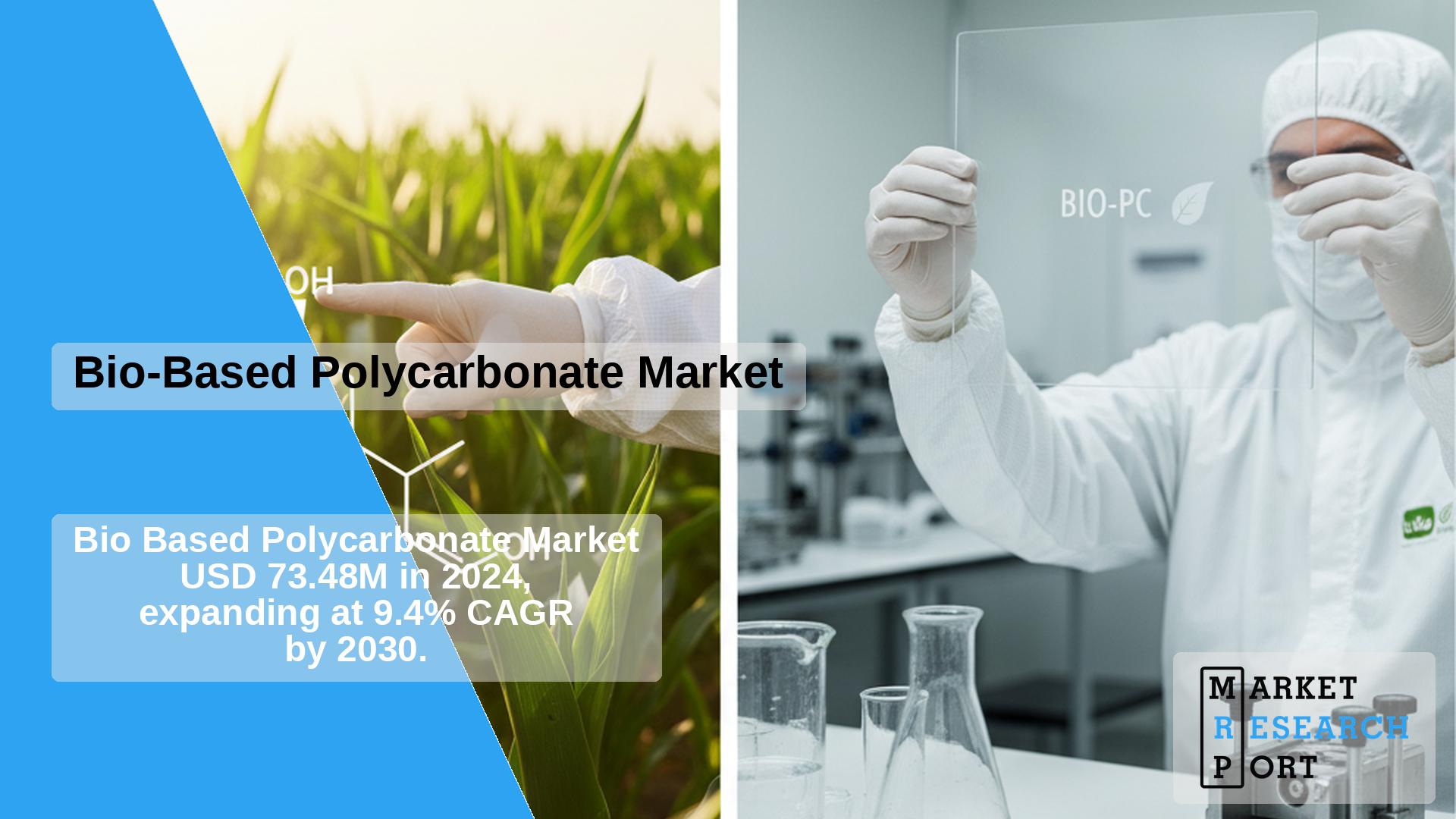
The global bio-based polycarbonate market was valued at approximately USD 73.48 million in 2024 and is expected to grow at a compound annual growth rate (CAGR) of 9.40% from 2025 to 2030. This growth is driven by expanding thermoplastic applications across industries and increasing awareness about the environmental consequences of petrochemical plastic waste. The U.S. market is poised to grow due to heightened environmental consciousness, technological advancements, stricter regulations, and consumers’ shift toward bio-based products.
Bio-based polycarbonates, often made from renewable resources such as plant-derived sugars, offer high thermal resistance, hardness, and transparency. These attributes help reduce carbon footprints while providing performance comparable to traditional petrochemical polycarbonates. Markets like automotive, electronics, and packaging are embracing these eco-friendly alternatives as regulatory pressures intensify in North America and Europe. Consequently, R&D efforts and collaborative industry initiatives are underway to develop bio-based polycarbonate products combining performance with sustainability advantages.
Government policies and international frameworks aimed at lowering carbon emissions drive the bio-based polycarbonate market. In the European Union and other regions, incentives like tax credits and subsidies encourage companies to adopt sustainable materials and invest in innovation. Bio-based polycarbonates enable organizations to meet emission reduction targets, enhance brand image, and cater to consumers’ growing demand for green products.
High-performance applications in sectors such as automotive, consumer electronics, and construction present significant growth potential. These industries seek durable and resilient materials from renewable sources, with bio-based polycarbonates addressing these needs effectively. By pursuing partnerships with eco-conscious brands, companies can expand market reach and capitalize on sustainability trends.
However, high production costs impede the market expansion. The complexity of sourcing and processing bio-based feedstocks, limited manufacturing capacity, and price volatility of raw materials make these polymers less competitive in cost-sensitive sectors. Scaling production and developing supply chains remain critical challenges to broader adoption.
The optical grade bio-based polycarbonate segment led the market with a 58.91% share in 2024. This segment benefits from demand in electronics and automotive industries, where optical clarity and eco-friendly materials are essential. These polycarbonates offer properties similar to traditional optical plastics but with a reduced environmental footprint, making them ideal for lenses, displays, and lighting components.
The general-purpose grade segment is also growing, driven by uses in construction, housing, containers, and consumer goods where durability and performance are needed without optical clarity. Increasingly, manufacturers prefer bio-based options with lower environmental impacts across industrial and consumer applications.
In 2024, the transportation segment accounted for the largest share of 34.28%, fueled by the automotive industry’s shift to lightweight materials that improve fuel efficiency and reduce emissions. Bio-based polycarbonates serve as robust yet lightweight alternatives in vehicle parts such as dashboards, headlamp lenses, and interior panels. Regulatory requirements in North America and Europe further drive material substitution.
The electrical and electronics sector values bio-based polycarbonate for its excellent insulation, heat resistance, and durability, making it suitable for housings, circuit boards, and components. Consumer demand for sustainable electronics contributes to market growth, as manufacturers reduce environmental impacts along production chains while maintaining product safety and reliability.
North America’s market growth is supported by corporate and consumer pushes for sustainability. Industries including automotive, electronics, and packaging adopt bio-based polymers to meet sustainability goals. Regulatory efforts to curb plastic waste reinforce this trend. U.S. and Canadian firms’ commitments to carbon neutrality further support bio-based polycarbonate adoption.
Federal and state policies promoting sustainable manufacturing, along with government incentives and funding, bolster bio-based polycarbonate growth. Consumer preference for environmentally responsible products, especially among younger demographics, accelerates adoption across automotive, healthcare, and electronics sectors.
Europe leads with stringent environmental regulations and initiatives like the Green Deal. Demand spans automotive, packaging, and consumer goods industries aiming to meet carbon reduction targets. Investment in innovative sustainable materials propels bio-based polycarbonate use.
Asia Pacific dominates globally with a 38.15% market share in 2024, driven by industrial growth and sustainability focus in countries like India, Japan, and South Korea. Supportive policies and initiatives encourage renewable material adoption in manufacturing.
China’s expanding advanced manufacturing sector and regulatory push towards eco-friendly materials contribute significantly to market growth. Demand increases in automotive, electronics, and packaging feed the expanding bio-based polycarbonate industry in China.
The market is competitive with companies investing heavily in innovation and sustainability. Key players include Mitsubishi Chemical Corp., Covestro AG, SABIC, and TEIJIN LIMITED, among others.
| Report Attribute | Details |
| Market size in 2025 | USD 79.19 million |
| Revenue forecast in 2030 | USD 128.84 million |
| Growth rate | CAGR of 9.40% from 2025 to 2030 |
| Historical data range | 2018 – 2023 |
| Forecast period | 2025 – 2030 |
| Quantitative units | Revenue in USD million, volume in kilotons, CAGR from 2025 to 2030 |
| Segments covered | Type, end use, region |
| Regional scope | North America; Europe; Asia Pacific; Central & South America; Middle East & Africa |
| Countries covered | U.S.; Canada; Mexico; Germany; UK; France; Italy; Spain; Netherlands; China; India; Japan; South Korea; Australia; Malaysia; Singapore; Thailand; Vietnam; Brazil; Argentina; Saudi Arabia; UAE; South Africa |
| Key companies profiled | Mitsubishi Chemical Corp.; Covestro AG; SABIC; TEIJIN LIMITED |
The market was estimated at USD 73.48 million in 2024 and is projected to grow to USD 79.19 million in 2025.
The market is anticipated to expand at a CAGR of 9.40% from 2025 to 2030, reaching USD 128.84 million by 2030.
The optical grade segment led the market in 2024 with a share of 58.91%, driven by applications demanding high clarity and environmental sustainability.
Key players include Mitsubishi Chemical Corp., Covestro AG, SABIC, and TEIJIN LIMITED, among others.
Increasing adoption of thermoplastic industrial applications and rising environmental awareness regarding petrochemical waste disposal are key market growth factors.